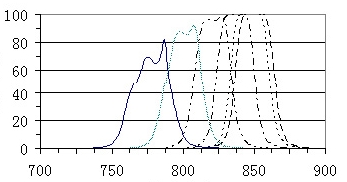ISO9001 Certified Professional Manufacturer & Supplier of Optics
+86-0431-87911611 admin@ytoptics.com
Contact us
-
 Email: admin@ytoptics.com
Email: admin@ytoptics.com
-
 Tel:86-0431-87911611
Tel:86-0431-87911611
-
 Add: 2# Automotive Innovation
Add: 2# Automotive Innovation
Jilin Province, China
Changchun Yutai Optics Co., Ltd.
Narrow Band Filter - Incident Point of View
The angle of incidence is the angle between the incident light and the normal to the filter, not to be misunderstood as the angle between the line connecting the orientation of the light source to the centre of the filter and the normal to the filter. If the light source is not collimated, even if the light source is oriented normal to the centre of the filter, the light will still diverge, i.e. the angle of incidence will not be 0°. If the incident light and the normal angle of the filter has a certain scale, then to specify the detailed scale of the angle, because the interference filter planning is very sensitive to the point of view, on the 0 ° under the planning of narrow-band filters, if used in different points of view, its role is completely different. The figure is to 850nm narrow band filter as an example, when the incident point of view increases, the position of the centre wavelength is constantly moving to the short wave. As long as the interference filter, this point of view effect can not be avoided, which is the fundamental characteristic of interference filters. As can be seen from the figure, when a narrow-band filter of 850nm is used at 50°, it is no longer a narrow-band filter of 850nm, but becomes a narrow-band filter of 770nm. Some users will reflect, in the use of wide-angle lens to take pictures of objects, add a narrow-band filter, found that you can only shoot the centre part of the object, the edge of the dark, that narrow-band filter is only the centre of the translucent, the edge of the impermeable, this understanding is not true, the narrow-band filter the entire surface is uniform, mainly because of the large point-of-view incidence, the filter's transmittance wavelengths to the short-wave shift, and the short-wave portion of the absence of a light source! caused by the absence of a light source in the short-wave portion.


PREV : Interferometric Infrared Filters NEXT : Narrow Band Filters - Cutoff Depth

TALK TO US 86-0431-87911611
86-0431-87911611
Call us now!
 86-0431-87911611
86-0431-87911611Call us now!
ONLINE CHAT
 2433808388
2433808388

